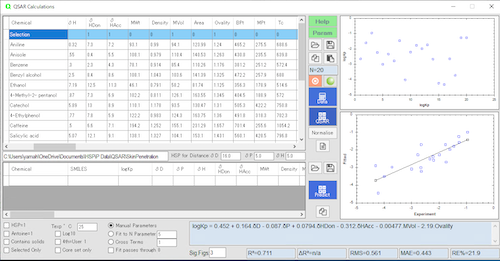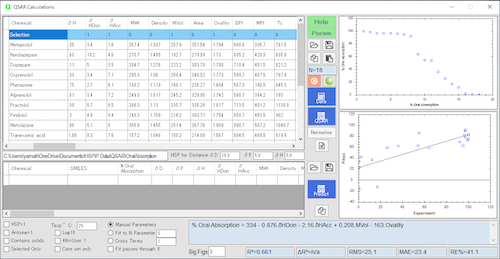HSPiP has included QSAR functionality since ver. 5. Among them are example problems of skin permeation and oral absorption.
Recently, I have been writing a blog on the pathway of skin permeation and Hansen solubility parameters, LD50 of rats and rabbits, and the difference between oral and dermal absorption, etc. These topics are of great interest to readers, as I have received many accesses. (although none of them ever comment on it).
In the PIRIKA research group that I have just started with my students, there are two students who are working on developing alternative methods for animal testing. So I explained the QSAR function of HSPiP at the research group.
If you load the skin penetration data (SkinPenetration.hsq) in HSPiP and press the QSAR button, you will get this result.

The formula obtained is,
logKp = 0.452 + 0.164.δD – 0.087.δP + 0.0794.δHDon – 0.312.δHAcc – 0.00477.MVol – 2.19.Ovality
In other words, once this QSAR formula is obtained, if you have the SMILES structural formula of the compound, HSPiP will calculate the required properties and return predicted values.
When the actual experiments are carried out and the results are obtained, the QSAR formula can be reconstructed again and again, and the performance becomes higher and higher.
The original data is in the following paper, which can be downloaded from the internet.
International Journal of Engineering Science and Technology Vol. 2(6), 2010, 1526-1531
If you load the oral absorption data (OralAbsorption.hsq) and press the QSAR button, you will get this result.

% Oral Absorption = 334 – 0.876.δHDon – 2.16.δHAcc + 0.208.MVol – 163.Ovality
The original document here is the following, which was also downloaded from the internet.
European Journal of Pharmaceutics and Biopharmaceutics 48 (1999) 259-263
The date of this data is 2015.6, which means that these calculations were done with HSPiP seven years ago.
It can be quite fun, automatically searching for variables, giving restrictions, and shaping the formula in your own way.(It’s a bit buggy and not all of it works)
I am currently working on new parameters for HSPiP.
What happens when I use them? is also an important issue for the pirika research group.

For example, the newly introduced parameters ED (Electron Donor) and EA (Electron Acceptor) are very good parameters for QSAR.
The inverse correlation between EA (Electron Acceptor) and % oral absorption was clearly visible and obtainable, but unclear for δHAcc.
In other words, the stomach is acidic, which means that the higher the EA (Electron Acceptor), the less likely it is to be absorbed.
This means that it contributes very much to the accuracy of the QSAR formula.
In the case of skin penetration, the correlation is not with δHDon but with ED (Electron Donor).

The HSP distance is very important in HSPiP theory and understanding.
However, the HSP distance is the smallest and zero, which is very problematic for QSAR.
Thus, it is important to understand that I am not just drawing SOMs and playing with them.
